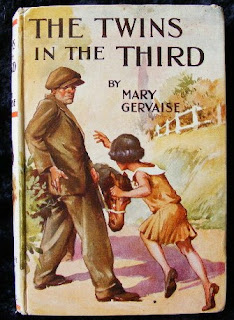Mary Gervaise and the early pony book
Just when you think you have a reasonable idea about an author, something pops up which makes you rethink. I've included Mary Gervaise in my book, Heroines on Horseback, and have recently written about her too. What I didn't know, until it turned up in a load of books I bought this week, was that she was a very early exponent of the girl plus pony story. In 1932, when The Twins in the Third was written, pony stories were generally stories told by the pony, and they weren't exactly numerous, being far outnumbered by the school story.
The Twins in the Third is a story where the ponies are an important part of the plot. They're not central: the author could just as easily have used some other device to achieve her aim of social inclusion for twins Jean and Laurie, but ponies, and the fondness the girls feel for them are there. The book illustrates a key factor of Gervaise's writing over the years: if she didn't intend to write a girl-gets-pony story, neither did she want to write a school story, despite the title. For someone known as a school story writer, she's remarkably reluctant for her characters to actually be in school. It's noticeable in the G for Georgia series, and it's noticeable here: most of the action takes place outside school. It's relationships at home and outside school that interest Gervaise most. The ponies, and the school, are merely convenient devices which let her write about what she's most interested in.
Twins Jean and Laurie have not been at the High School for long. They are both shy, and although most of their classmates are willing to give them the benefit of the doubt, the twins have been uncommunicative for so long, most of the other girls have ceased to bother with them. The twins don't like it, and indeed some of their classmates are worried about it too. This gives the start of the book an interesting tension.
This situation probably would have carried on for months, had not the form been collecting to fund a child's cot in the local hospital. The third form have fallen behind, and are some way off their £2.00 target. Everyone can contribute a little something to the total, surely? says the form mistress. In Jean and Laurie's case, no, they can't. They're staying with their grandmother, who doesn't believe in pocket money, and the girls therefore have nothing to give. They're too proud to explain, and so appear to their form as misers. They are determined not to spill the beans on their grandmother, whom they love, and are desperate to earn money somehow to contribute to the cot. They decide to sell their watches. On the way to sell them, they come across a man ill treating a pony and they trade in their watches for the pony.
The Twins in the Third is a story where the ponies are an important part of the plot. They're not central: the author could just as easily have used some other device to achieve her aim of social inclusion for twins Jean and Laurie, but ponies, and the fondness the girls feel for them are there. The book illustrates a key factor of Gervaise's writing over the years: if she didn't intend to write a girl-gets-pony story, neither did she want to write a school story, despite the title. For someone known as a school story writer, she's remarkably reluctant for her characters to actually be in school. It's noticeable in the G for Georgia series, and it's noticeable here: most of the action takes place outside school. It's relationships at home and outside school that interest Gervaise most. The ponies, and the school, are merely convenient devices which let her write about what she's most interested in.
Twins Jean and Laurie have not been at the High School for long. They are both shy, and although most of their classmates are willing to give them the benefit of the doubt, the twins have been uncommunicative for so long, most of the other girls have ceased to bother with them. The twins don't like it, and indeed some of their classmates are worried about it too. This gives the start of the book an interesting tension.
This situation probably would have carried on for months, had not the form been collecting to fund a child's cot in the local hospital. The third form have fallen behind, and are some way off their £2.00 target. Everyone can contribute a little something to the total, surely? says the form mistress. In Jean and Laurie's case, no, they can't. They're staying with their grandmother, who doesn't believe in pocket money, and the girls therefore have nothing to give. They're too proud to explain, and so appear to their form as misers. They are determined not to spill the beans on their grandmother, whom they love, and are desperate to earn money somehow to contribute to the cot. They decide to sell their watches. On the way to sell them, they come across a man ill treating a pony and they trade in their watches for the pony.
None of this makes their lives any easier, but the book works its way through to just the conclusion you'd expect. It's the sort of warm and involving story Gervaise carried on producing throughout her life. She didn't go on to write traditional pony stories: she was a writer who wrote what would sell, but whatever badge her publishers put on her books over the years, she wrote what she wanted to write: books on children and their relationships.



Comments